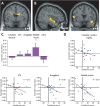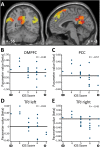Entrepreneurial and parental love-are they the same?
- PMID: 28295978
- PMCID: PMC5516169
- DOI: 10.1002/hbm.23562
Entrepreneurial and parental love-are they the same?
Abstract
Here we tested the hypothesis that entrepreneurs' emotional experience and brain responses toward their own firm resemble those of parents toward their own children. Using fMRI, we measured the brain activity while male entrepreneurs viewed pictures of their own and of a familiar firm, and while fathers viewed pictures of their own and of a familiar child. The entrepreneurs who self-rated as being very closely attached with their venture showed a similar suppression of activity in the posterior cingulate cortex, temporoparietal junction, and dorsomedial prefrontal cortex as fathers during viewing pictures of their own children versus familiar children. In addition, individual differences in the confidence trait influenced the neural encoding of both paternal and entrepreneurial processing. For underconfident fathers, a picture of one's own child was associated with stronger activation and for overconfident fathers with weaker activation in the amygdala and in caudate nucleus, a brain structure associated with processing of rewards. Similar association with activation, yet more widespread in the emotional processing network, was observed in entrepreneurs suggesting a similar neural basis for increased sensitivity to threats and potential risks concerning one's venture and child. In conclusion, both entrepreneurial and parental love seem to be supported by brain structures associated with reward and emotional processing as well as social understanding. Hum Brain Mapp 38:2923-2938, 2017. © 2017 The Authors Human Brain Mapping Published by Wiley Periodicals, Inc.
Keywords: affect; behavior; entrepreneurship; functional magnetic resonance imaging (fMRI).
© 2017 The Authors Human Brain Mapping Published by Wiley Periodicals, Inc.
Figures





Similar articles
-
Neural signatures of parental empathic responses to imagined suffering of their adolescent child.Neuroimage. 2021 May 15;232:117886. doi: 10.1016/j.neuroimage.2021.117886. Epub 2021 Feb 19. Neuroimage. 2021. PMID: 33617996
-
Explaining individual variation in paternal brain responses to infant cries.Physiol Behav. 2018 Sep 1;193(Pt A):43-54. doi: 10.1016/j.physbeh.2017.12.033. Epub 2018 May 3. Physiol Behav. 2018. PMID: 29730041 Free PMC article.
-
Mothers' neural activation in response to pictures of their children and other children.Biol Psychiatry. 2004 Aug 15;56(4):225-32. doi: 10.1016/j.biopsych.2004.05.017. Biol Psychiatry. 2004. PMID: 15312809
-
Age-related changes in amygdala-frontal connectivity during emotional face processing from childhood into young adulthood.Hum Brain Mapp. 2016 May;37(5):1684-95. doi: 10.1002/hbm.23129. Epub 2016 Mar 2. Hum Brain Mapp. 2016. PMID: 26931629 Free PMC article.
-
How do we empathize with someone who is not like us? A functional magnetic resonance imaging study.J Cogn Neurosci. 2010 Feb;22(2):362-76. doi: 10.1162/jocn.2009.21186. J Cogn Neurosci. 2010. PMID: 19199417
Cited by
-
Integration of Neuroscience and Entrepreneurship: A Systematic Review and Bibliometric Analysis.Front Psychol. 2022 Apr 1;13:810550. doi: 10.3389/fpsyg.2022.810550. eCollection 2022. Front Psychol. 2022. Retraction in: Front Psychol. 2024 Sep 12;15:1490714. doi: 10.3389/fpsyg.2024.1490714. PMID: 35432139 Free PMC article. Retracted. Review.
-
Six types of loves differentially recruit reward and social cognition brain areas.Cereb Cortex. 2024 Aug 1;34(8):bhae331. doi: 10.1093/cercor/bhae331. Cereb Cortex. 2024. PMID: 39183646 Free PMC article.
References
-
- Acevedo BP, Aron A (2009): Does a long‐term relationship kill romantic love? Rev Gen Psychol 13:59–65.
-
- Aron A, Aron EN, Smollan D (1992): Inclusion of other in the self scale and the structure of interpersonal closeness. J Persona Social Psychol 63:596–612.
-
- Aron A, McLaughlin‐Volpe T (2001): Including others in the self: Extensions to own and partner's group membership In: Sedikides C, Brewer MB, editors. Individual Self, Relational Self, Collective Self. Philadelphia: Psychology Press; pp 89–108.
Publication types
MeSH terms
Substances
LinkOut - more resources
Full Text Sources
Other Literature Sources

